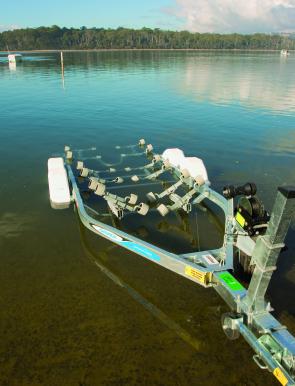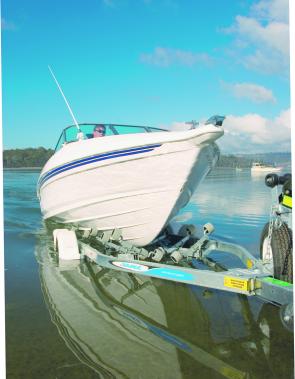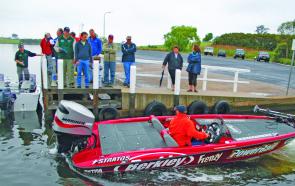It is often said that the two happiest days in boat ownership is the day you buy the boat and the day you sell it!
Boating can be the most pleasurable of activities, especially once you are out on the water. However it is the launching and retrieving that causes most of the problems and in many ways is the real reason that anglers get rid of their boats.
There are a few simple tricks to launching and retrieving boats that can make life a whole lot easier for you and those around you – particularly those waiting behind you to get on or off the water!
There are more harsh words spoken on boat ramps than just about anywhere else on the water. Some guys think that they own the ramp; others are hyper-critical of other ramp users and others will just dawdle about, totally ignorant of the other 30 boats keen to get onto the water. Much of this angst can be avoided if boat owners follow some simple guidelines. Get your boat ready for the days fishing well away from the ramp. Nothing annoys other boat users more than to sit and wait while some one rigs their rods, puts eskies in the boat and generally fiddles and faffs about while occupying the ramp. Stow everything and prepare the boat for launching in a place where you aren’t holding up other users. If there is a queue then get in it and stay in it.
The same goes for packing everything away after the days outing. Please don’t just pull the boat from the water, drive 10m forward and then pack up. Move the boat out right of the way so others can get out of the water as well.
If you are able, give a hand to boaters who might be struggling. Elderly boat users often appreciate a hand, as do boating beginners. Apart from helping them out, you are also making the process much quicker as well – a small point, but worth bearing in mind.
Nothing causes more problems when launching and retrieving boats than a poorly set up or ill maintained trailer. Even new trailers can be difficult things to manage in less than ideal circumstances! There are a number of aspects to trailer design and maintenance that will make your life a lot easier. Usually when you buy a new boat, motor and trailer package the trailer will be spot on for what you need, but always make sure you talk to the sales person about the trailer, it is very important to the whole enjoyment. If in doubt ask the dealer if you can upgrade the trailer to what you need right from the start.
The key issue is setting up the trailer so that the boat aligns to the centre very easily. Most problems with retrieving boats arise from the boat not being centred on the trailer. There are two key ways to do this: either with a deep V on either side of the rear roller which pushes the hull straight into the centre, or with two vertical guides on each side of the trailer. This one aligns the boat with contact on the gunnels, rather than the hull V. Either or both is good – a combination of the two is very handy if you regularly use ramps with strong side currents or cross winds (the main ramp at Inverloch is a good example).
Other trailer issues revolve around poorly maintained trailer rollers (that don’t roll or don’t touch the hull), or skids that don’t allow the boat to slide off. Trailer maintenance is the key here – just remember that the boat spends more time on the trailer than on the water, so it is well worth looking after.
Winches are often a problem as well – keep the lubrication up to them. Strap winches (using a material similar to a seat belt) are very common, but be careful to ensure that the strap lies evenly on the winch as you wind in – the can twist easily which will eventually lead to the strap breaking – always at the worst time! If the boat is a very heavy one and you could consider an electric winch – they take the grunt out of things!
Given a decent ramp, there shouldn’t be too many problems in launching a boat. There are plenty of places where launching ramps are far from ideal, (like Blackrock in Port Phillip), but mostly Victorian boaters fare reasonably well in the boat ramp stakes.
The main thing in getting the boat off the trailer is that the trailer is deep enough in the water to allow the boat to be pushed off easily. It is very rare that you can launch (or retrieve) a boat without the need to get in the water, so be prepared with either gumboots or waders if the water is cold. Once the boat is deep enough into the water simply push it off and secure it while you park the trailer.
Securing the boat after launching it is important on two levels. Obviously the first is to make sure it doesn’t drift away, but the other is to secure it so that it doesn’t impede other ramp users. This is sometimes not possible, but usually there is a spot out of the way. As mentioned before, stow everything in the boat and get the tie downs off before you approach the ramp, but don’t loosen the winch rope or safety chain until the boat is in the water! Don’t forget to check the bungs, either!
1. Make sure the engine will start before you launch the boat – a few seconds of dry running wont hurt it and will ensure a smooth get-away.
2. Check the bungs are securely in place – you would be surprised how often this simple thing is overlooked, even by experienced boaters!
3. If you are launching on your own, ensure that your bow rope (or painter) is already in place at the bow, this will help secure the boat after launching quickly.
4. Put your lifejackets on before getting into the boat – this is when accidents can happen!
5. Get the trailer properly submerged when launching – it will make the whole process much easier.
This is often the hard bit. The wind blows the boat side ways, the current is working against you, there are three boats behind you and the pressure is on. This is probably the most hated part of the whole boating day, but there are some simple tricks to making life a whole lot easier, even in adverse conditions. The key is planning and practice, but also looking at the conditions and working with them, not against them.
Essentially, the depth the trailer is in the water is the key to an effective retrieve. Too deep and the boat can misalign on the trailer – too shallow and it is too much effort to winch it on. Get it right and it should slide up straight each time.
The key point is the rear centre roller on the trailer and what depth is sits in the water. Ideally on a well set up trailer the rear centre roller should be just in the water – half in, half out. When this is properly aligned, the bow V of the boat should hit this in the centre and providing there is no sideways gale or strong current, should allow the boat to be winched straight up onto the trailer nicely. The same goes for driving the boat onto the trailer – it must be at the right depth to allow the boat to centre up. Deep V fibreglass boats often come with a well rollered trailer which also helps immensely. This is all quite straightforward – but conditions aren’t always perfect!
Retrieving boats is easy enough when it is flat calm and there is no sideways influence on the boat from either currents or wind. One trick that can be used to lessen the effect of the wind is to use a rope from the stern and back to the winch – see the diagram for a clearer explanation. If you have someone helping you, then have them hold the rope up wind of you – that way the boat can be easily pulled up the trailer.
Probably the hardest retrieve is when there is a wave pushing either across or behind the trailer as you retrieve the boat. This can be quite difficult to get right, but the best bet is to put the trailer in shallower rather than deeper. Whilst this makes it a bit heavier to winch the boat on, it does mean that waves are less likely to push the boat off-centre.
1. Secure the boat so it doesn’t blow away while you get the car and trailer
2. Make sure that the rear centre roller is at the right depth in the water
3. In windy conditions use a stern rope to keep the boat winching on straight
4. Once the boat is properly secured on the trailer move out of the way to keep the ramp clear for other boaters.
Launching and retrieving can be daunting for may boat owners, however with a few basic principles up your sleeve and a little practice it can be the easiest and trouble free part of the day.
Facts
A Basic Guide to Boat Trailer Maintenance
Wash that salt away
There are three certainties in life: death, taxes and trailer corrosion. Rinsing will greatly prolong your trailer’s life Wash your trailer after each use after every use in saltwater and make sure you leave enough time to do this every time! Rinse every part of the trailer with fresh water, especially the suspension and behind the wheels. Use plenty of water to flush the brakes of your trailer. Saltwater is very corrosive and especially so inside braking components. Protect your tailer hardware with anti-corrosion spray that is usually available at some boating stores. Make sure you spray the nuts, bolts, leaf-springs, winch gears and all other hardware items thoroughly.
Tie your boat down
Use tie down straps rather than rope. The good quality ratchet-type straps help secure your boat to the trailer better than rope. Don’t skimp on the quality of the tie-downs either – remember that they are holding down your pride and joy. Every boat should be secured with several. Remember that your winch strap is not a tie down strap. All boats should be secured at the bow with the winch strap/rope but there should always be a safety chain mechanism in place should the winch let go and they do!
Grease is the word
Do this every couple of weeks when you are using the boat regularly. If you are only getting out once every couple of months make the bearings are greased at least once a year. To do this, remove the hub cover. Locate the grease nipple and squeeze grease from the gun until the bearings are full. You will know when it is too full as grease will squirt everywhere. As a guide just give it three or four pumps. Many experienced boating people recommend using heavy -duty marine grease so get the best. Every now and again stop on a long trip (over and hour) and feel your hubs for excess heat when travelling. They should not feel any hotter than a nice cup of tea. One idea is to use Bearing Buddies or other such bearing-saving devices. Milky grease is a sign that it has been compromised by water. If this happens, repack all bearings.
While we are on the subject of lubrication, you may as well give your wheel studs and nuts a good lube as well, so that you will be able to loosen them to change tires. This is especially important if you are fixing a flat by the side of the road. Wheel nuts tend to rust easily, especially the steel ones. If you can maybe consider replacing steel nuts with stainless steel.
Tyres – where the rubber meets the road
Always check your tire pressure – differences in daily temperatures will effect them. Trailer tires are usually different from car/4WD tires, so check the tire wall for correct pressure and pump them up with a good quality compressed air tool. Keep an eye on the tyre tread as well. Single axle trailers are usually very long lived, but tandem axle trailers can scrub out if you are regularly turning tightly.
Lights
Check the lights every time you connect the trailer to your vehicle. This is the most common failure on trailers and probably the cause of more tickets from the boys in blue! Have someone depress the brake pedal and use the indicators while you stand behind the vehicle and ensure the correct lights illuminate don’t forget the headlights.
Connect the trailer properly
It is amazing how many people don’t do this properly. Chris-cross the chains below the tongue, so that if the trailer does come off the ball it will be ‘caught’ by the chains and allow you to stop without the trailer digging into the road or worse still, jack-knifing at speed. Don’t use anything else but shackles and make sure that they are nice and tight.
Prepare for an emergency
As you do with your car, carry emergency equipment for your trailer. Make a trailer emergency kit that contains a spare wheel and tire, wheel wrench, a jack that works and is capable of lifting the trailer, wheel chocks, bearing grease, extra hub assembly, a spare tie-down strap, replacement light bulbs, and even wheel bearings if you are headed on a long trip.

The trailer is correctly placed into the water – not too deep and not too shallow

Driving the boat up the trailer, this requires a good trailer, a competent driver and correct placing of the trailer in the water.

Adam Royter uses some brute force in getting a Stratos tournament boat off the trailer.

Bigger boats are better driven off the trailer rather than pushing them. This provides better control over the boat, as trying to hold a big boat on a rope if it slides off to quickly can be dangerous and embarrassing!




